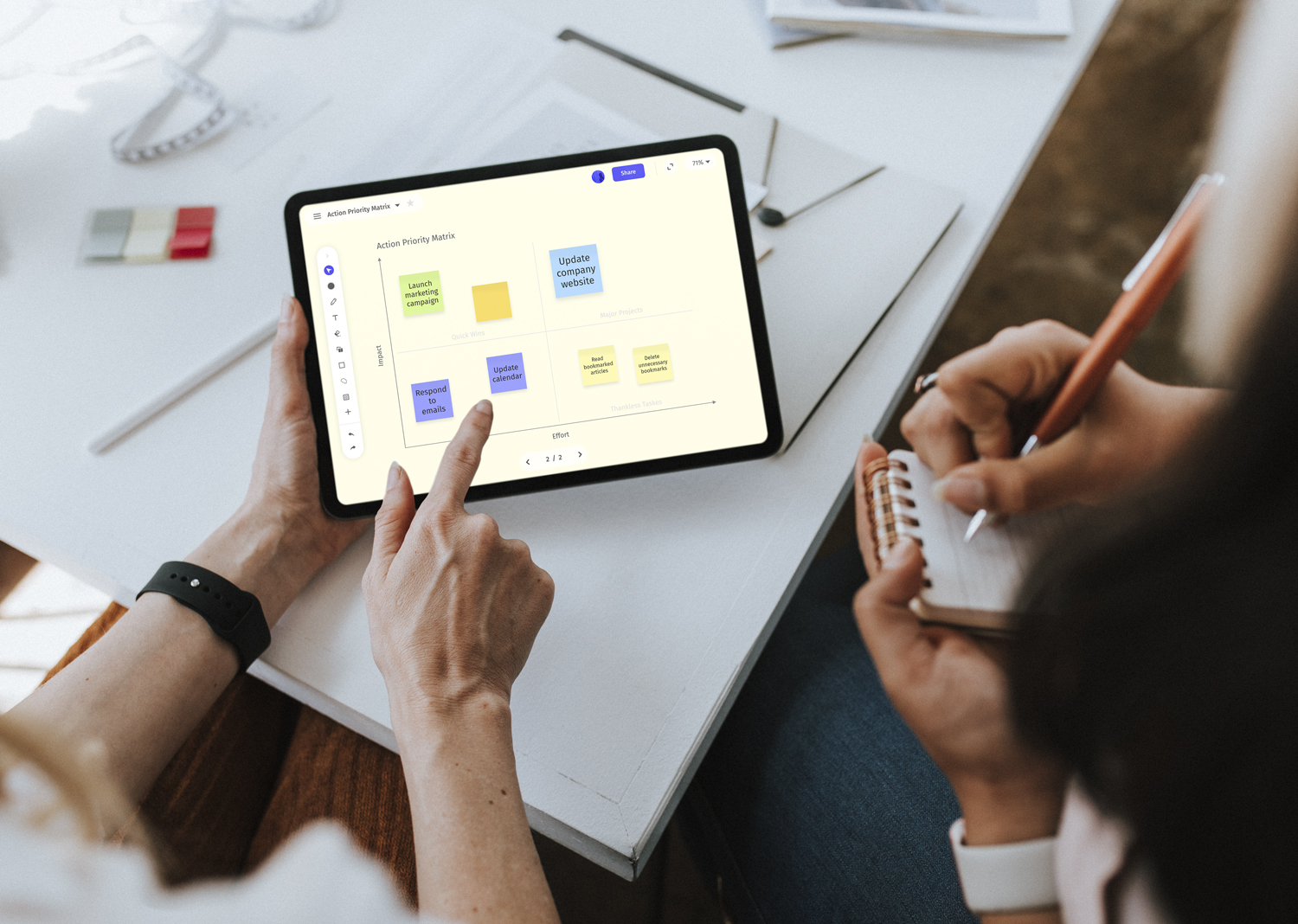We all have to-do lists. Whether they live on a fridge, a phone, or in our minds, we all have varying goals we’d like to accomplish. Unfortunately, many of these goals are kicked to the curb when we run out of time and resources. And this can lead to a serious case of unproductivity. You may find yourself experiencing the following symptoms of this common issue:
- A to-do list that’s a mile long
- Constantly struggling to put out fires
- Trouble delegating or saying "no"
- Unable to meet long-term goals
- Lack of focus and direction
- Consistently busy but feel like you’re not making an impact
Why do these troublesome symptoms occur? When a task is of little importance to you, your brain naturally loses focus as you work on the task. This opens the door for distractions to knock you off course. The key is figuring out how to prioritize tasks so you can tap into your brain’s selective attention power and make the best use of precious time and talent. This is where the action priority matrix comes in to save the day.
How to use an action priority matrix
Because we’re human and time is a finite resource, we typically can’t complete every task we would like to accomplish in a given time frame. The action priority matrix is a handy tool that helps you decide which tasks demand your immediate attention while highlighting the more insignificant tasks that can be tossed aside.
The action priority matrix is related to the Eisenhower Matrix, developed by Stephen Covey, bestselling author of "The 7 Habits of Highly Effective People." But rather than prioritizing activities based on their importance and urgency, tasks in an action priority matrix are measured against effort and impact.
Effort (along the x-axis) is the time and resources needed to complete a task, while impact (along the y-axis) is the benefits (e.g., sales, workforce morale, customer satisfaction) that come from completing a task. Once tasks are evaluated based on their effort and impact, they are placed in one of four quadrants, providing a clear picture of which tasks need to come first.
Related: What is Attention Residue? Why It's Bad for Your Team
 Too many tasks? Organize them by effort and impact.
Too many tasks? Organize them by effort and impact.Components of an action priority matrix
1. Quick Wins (High impact, low effort)
Tasks in this quadrant should come first on your to-do list. With little effort, you get a lot in return when you check these off.
Research by Harvard Business Review found that those who focused on completing short tasks first and then working through the rest of their tasks were the most satisfied with their job, felt the highest level of motivation, and had accomplished the most throughout the week.
Generally, when we finish tasks in the quick wins area, we feel good. Those good feelings propel us forward to tackle more challenging tasks, like major projects.
Example tasks: Launch a marketing campaign, lead a brainstorming session, call back a sales lead, discuss plans with clients, prepare a lesson
2. Major Projects (High impact, high effort)
Major projects are time-consuming but rewarding. While you need to prioritize these tasks, be careful how you schedule your time for these; you don’t want to miss out on quick wins.
Projects can often be broken down into smaller chunks (think 30-90 minutes each) that require lower effort.
Example tasks: Update a website, schedule content publication, design a new product, prepare blueprints for clients, grade student projects
3. Fill-ins (Low impact, low effort)
Work on these tasks when you have extra time in your schedule (say 15-30 minutes). Fill-ins are best to do right before you have something scheduled — like a meeting, lunch or going home — as they can be easily interrupted and don’t require much effort.
These fill-ins can also be beneficial to complete when you’re losing energy and need a boost that’s still productive. In other words, when the temptation to peruse social media or shoot the breeze with coworkers hits you, opt for completing a fill-in task instead.
Example tasks: Respond to emails, organize files, pay an invoice, book travel for a conference
4. Thankless Tasks (Low impact, high effort)
Thankless tasks sit at the very bottom of your priorities. If possible, try to delegate them out or simply remove them from your list. Should you find that a task is not an integral part of helping your business stay successful, consider removing it from your future schedule altogether.
Example tasks: Scroll through social platforms, read internet news articles, complete miscellaneous clerical work
 Use one of Vibe's templates to create your own action priority matrix.
Use one of Vibe's templates to create your own action priority matrix.5 steps to using an action priority matrix
If you have "create an action priority matrix" on your to-do list, you’ll be pleased to find that it easily falls into the "quick wins" category. This life-changing tool can be created and used in five easy steps:
Set the time frame
Are you going to focus on the tasks for the upcoming day, month, or year? Pick a time frame that will allow you to feasibly accomplish your goals without getting overwhelmed. When in doubt, start with a small timetable and work your way up to more long-term goals.
List tasks
Determine which tasks you would like to accomplish within your time frame. Using a tool like an interactive whiteboard is super helpful for this step, especially when brainstorming with your team. If possible, make a note of how long certain tasks take — this will help with the next step.
Score tasks
Rank each item on its impact and effort levels. Tasks can be scored using a 1-10 scale (with one as the lowest and 10 as the highest), a school grading scale (with A as the highest and F as the lowest), or any method that works best for you.
Think carefully about the effort level when assigning tasks to quadrants. You may feel like a task is high effort if it’s emotionally or mentally draining, but it might not take very long to complete. There may be more quick wins on your list than you think.
Plot tasks
This step may bring back memories of algebra class. Label each axis with even increments from 1-10, or whichever scale you chose when scoring. Plot each task directly on the matrix according to the score given.
Plan and prioritize
Review your matrix to create an organized plan for tackling each project, assigning items to teammates if applicable. Although there is no right or wrong way to select the order for your tasks to be completed, as a rule of thumb, quick wins usually take priority, and major projects come next. After these tasks are completed, or where there are holes in your schedule, work on fill-in activities or delegate them out. Try to completely eliminate thankless tasks or assign them to someone else.
Benefits of using an action priority matrix
Creating a diagram may seem like one more assignment to add to your already long list of tasks. But creating a game plan for how to get the most out of your time and resources can make a huge impact on your success as a business or individual. The following are just a few of the many benefits to consider.
Work more efficiently as a team
When you have a grasp on the general effort and impact levels of tasks, it’s easier to divvy up duties and create a more balanced workload among your teammates. Coming together with unique strengths and weaknesses, teams can decide which tasks are best suited for each person. Living in a world where remote business is the new norm, tools like Vibe Board can further simplify this collaboration.
Back up decisions with evidence
Sometimes you need approval from a client or stakeholder before moving forward with a task. An action priority matrix delivers objective data that justifies why tasks should be completed in a certain order. This visual tool packs a powerful punch when you’re trying to get everyone on the same page.
Reduce stress and stay on track
When a to-do list is long, it’s easy for our brains to fall victim to analysis paralysis, a debilitating state of indecisiveness. Not only is this stressful, but it forces us to waste time feeling overwhelmed when important tasks could be accomplished. Once you begin to delegate or delete tasks that are classified as fill-ins or thankless tasks, you can focus your time on the projects that make the greatest impact.
Experience the power and confidence that comes from prioritizing. Create your own action priority matrix with little effort and major impact using one of Vibe’s many user-friendly templates. With all the bells and whistles required for remote collaboration, Vibe has what you need to keep your whole team on task. Learn more about maximizing your time by exploring our detailed guides and case studies on our blog.
Vibe offers a collaborative solution combining an interactive digital whiteboard and innovative smart software. Increase engagement and efficiency at your brainstorming sessions, virtual training, and classroom sessions by integrating your favorite applications with video conferencing and an infinite, mess-free writing canvas. Collaborate today with Vibe.
Looking for the latest in interactive whiteboard technology? Check out Vibe today!








-1sbltxxq4FYxHrXrwJVLsCDNsXpqNa.webp)
-5Zp0pmSytvcuYDVs1LvuwplKuRneK0.webp)
